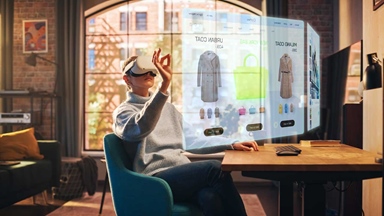Loading component...
At a glance
Economics consultancy Analysis Group estimates that by 2030, people could be spending about a third of their time in the metaverse – the emerging digital world of augmented, virtual and mixed reality.
Such a behavioural transition is likely to have an economic impact, as new products and business models could attract people to the digital realm to spend their money – perhaps with cryptocurrency.
It’s easy to be cynical about the economic impact of the metaverse when nearly US$650,000 (A$978,000) was paid in cryptocurrency for a virtual yacht moored in the Sandbox, a digital reality. Yet some of the world’s leading banks and IT consultancies predict big things from “metanomics” – the emerging term for commerce in the metaverse.
Physical to virtual
According to management consultancy firm McKinsey, US$120 billion (A$181 billion) was invested in the metaverse between January and May 2022 by corporates, venture capitalists and private equity firms. This is more than double the US$57 billion (A$86 billion) invested in 2021.
Bank group and asset manager JPMorgan looks beyond the world of virtual yachts and real estate in platforms like Sandbox and Decentraland to see the metaverse as a new market for household names like Nike, Gap and Hulu.
In its 2022 Opportunities in the metaverse report, JPMorgan says, “Business leaders and boardrooms around the world are now asking themselves, ‘What is my metaverse strategy? What am I supposed to be doing in the metaverse? What is the metaverse anyway?’”.
According to the report, US$54 billion (A$81 billion) is transacted on virtual goods every year. This is double the amount spent on music. Second Life – the first mover and shaker in creating a digital world – had a GDP of about US$650 million (A$978 million) in 2021, with almost US$80 million (A$120 million) of that going to content creators.
Analysis Group estimates that the metaverse could contribute up to US$3 trillion (A$4.5 trillion) to global GDP by 2031.
“The metaverse is expected to have far-reaching applications, with the potential to transform a wide range of economic sectors such as education, healthcare, manufacturing, job training, communications, entertainment, and retail,” the firm’s report said.
Deployment
Some IT consultancies are also thinking about metanomics. According to analysis from market consultancy firm Frost & Sullivan, there could be a US$750 billion (A$1.1 trillion) global metaverse market opportunity by 2030.
Frost & Sullivan surveyed more than 1700 companies globally in the last quarter of 2022, and 89 per cent of the respondents said they believed the metaverse held “moderate to significant” potential.
Fifty-eight per cent of the surveyed companies are conducting trials and proof of concepts, while 23 per cent are moving to large-scale commercial deployment.
Where do opportunities lie?
Frost & Sullivan research director Kiran Kumar says the opportunities are primarily in consumer sectors, such as a retail market for virtual products like accessories, collectibles and clothes, and a market for consumers to virtually attend or participate in sporting and music events.
The gaming sector has also been an early adopter of metaverse technology.
There are also many “emerging use cases” for other sectors to allow them to capitalise on the potential of the metaverse, says Kumar.
“More than two-thirds of the enterprises globally are looking to increase their investments in the immersive technologies over the next two years,” says Kumar.
“We believe the metaverse will be a bigger theme like digital transformation, which would be resilient to economic downturn and reflect high secular growth in the foreseeable future.”
Virtual products tend to be inexpensive to create and are accessible to a larger user base. Together, this creates an opportunity to create economic value, he says.
JPMorgan notes that the virtual world has developed an “ownership economy” driven by Web 3.0. This extends to owning virtual art and plots of land. The average price of a parcel of virtual land doubled over six months in 2021 to US$12,000 (A$18,000).
Brands are buying up space for virtual stores and other experiences. World-famous shopping district Harajuku, in Japan, is the inspiration for Metajuku, a virtual shopping district developed by Everyrealm for Decentraland.
In virtual stores and shopping districts, brands that began in the physical world could begin to take up space alongside metaverse start-ups, as the business world capitalises on the opportunities created by the increasing digitalisation of human behaviour.

